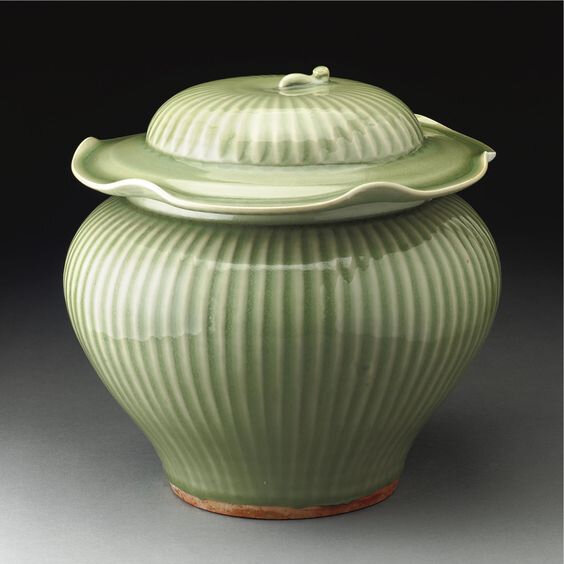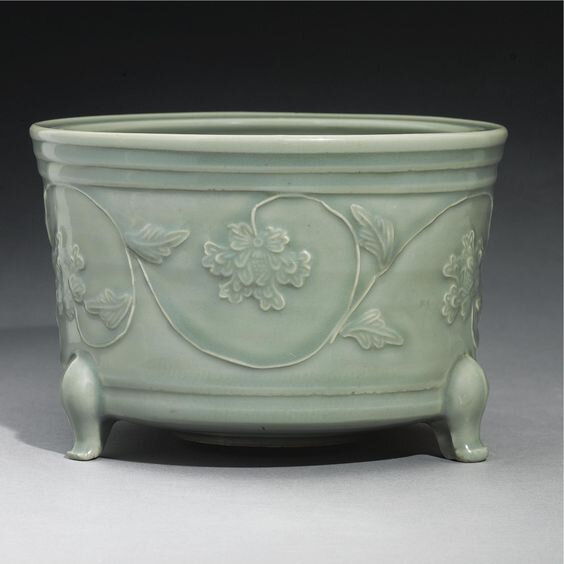Yuan dynasty 'Longquan' Celadon Ceramics sold at Sotheby's New York, 18 March 2008
Lot 99. A rare 'Longquan' celadon 'hundred rib' jar and cover, guan, Yuan dynasty (1279-1368); height 11 1/2 in., 29.2 cm; diameter 11 in., 27.9 cm. Estimate USD 40,000 — 50,000. Lot sold USD 79,000. © Sotheby's.
beautifully potted, of wide baluster form swelling generously from a short, slightly tapered foot, the gently curved neck supporting the wide undulating cover, its flared rim in the form of a lotus leaf, the domed center featuring a knop in the form of a scrolling stem, accentuated throughout with slender vertical ribs, the unctuous bubble-suffused glaze pooling to a deeper green in the recesses, stopping short of the unglazed foot, revealing the pale gray body burnt reddish-orange in the firing (2).
Provenance: Sotheby's Hong Kong, 1st November 1994, lot 12.
Note: Large 'Longquan' vessels of this elegant form and abstract ribbed design were much favored by the export market during the Yuan dynasty and can be found in many overseas collections. For example see a similar jar and cover recovered from the ship wrecked off the coast of Korea in 1323 A.D. illustrated in Relics Salvaged from the Seabed Off Sinan, Materials I, Seoul, 1985, pl. 30, fig. 37a and 37b, together with another jar of this type lacking its cover, pl. 31, fig.38. Compare also one from the collection of the Ottoman sultans and now in the Topkapi Saray Museum, Istanbul, included in Regina Krahl, Chinese Ceramics in the Topkapi Saray Museum, Istanbul, London, 1986, pl. 213.
A large jar and cover of this type can also be found in the Tokyo National Museum published in the Illustrated Catalogue of Tokyo National Museum. Chinese Ceramics II, Tokyo, 1990, cat.no. 14. Another, unearthed in 2002 and 2003 at the Jin and Yuan period ancient city site of Jininglu in Inner Mongolia, was published in Neimengu Jininglu guchen yizhi chutu taoqi, Beijing, 2004, pl. 61, and is of very similar size to the present jar. Compare also a jar and cover, from the Hardy collection, sold at Christie's New York, 21st September 1995, lot 121; and one with a later wood cover sold in these rooms, 6th December 1989, lot 144.
Lot 106. A rare 'Longquan' celadon double-gourd vase with applied decoration, Yuan dynasty (1279-1368); height 12 1/4 in., 31.1 cm. Estimate USD 60,000 — 80,000. Lot sold USD 73,000. © Sotheby's.
the two bulbous bodies forming the double-gourd decorated in the round with a lively display of sprig-molded scrolling peony, rising to an upright neck, covered overall in a thick unctuous blue-green glaze, the foot rim unglazed and burnt an orange color in the firing.
Provenance: Christie's Hong Kong, 30th October 1995, lot 679A.
Note: It is rare to find 'Longquan' vases of this elegant and highly auspicious double-gourd form decorated with a peony scroll on both the lower and upper bulbs. A closely related but slightly larger double-gourd vase, fitted with a later Ottoman metal mount and now in the Topkapi Saray Museum, Istanbul, is published in Sekai toji zenshu, vol. 13, Tokyo, 1981, pl. 31, and also in Regina Krahl, Chinese Ceramics in the Topkapi Saray Museum, Istanbul, vol. 1, London, 1986, pl. 202. A slightly smaller gourd-shaped bottle with a chrysanthemum scroll around the lower bulb and chrysanthemum flower-heads at the top, in the Datong Municipal Museum, Shanxi province, is illustrated in Zhongguo taoci quanji, vol. 10, Shanghai, 2000, pl. 34; and another with small sprigs of asters at the top and a composite scroll of peony and lotus at the bottom, in the Museum of Chinese History, Beijing, is published in Longquan qingci, Beijing, 1966, col. pl. 18, and in Celadons from Longquan Kilns, Taipei, 1998, pl. 153.
A 'Longquan' vase of this type was sold in these rooms, 30th March 2006, lot 57; and another vase, originally of double-gourd form but the top bulb damaged and missing, from the Alexander collection and illustrated in R.L. Hobson, Chinese Ceramics in Private Collections, London, 1931, fig. 7, was sold in our London rooms, 11th July 1978, lot 172.
'Longquan' wares with molded and applied decoration first appeared in the late Song dynasty but became popular and were produced in larger quantities during the Yuan dynasty. Double-gourd-form containers have been highly favored historically for their reference to gourds with their many seeds which symbolize fertility and abundance.
Lot 107. A large 'Longquan' Celadon Tripod Censer with applied decoration, Yuan dynasty (1279-1368); diameter 8 in., 20.4 cm; height 5 1/2 in., 14 cm. Estimate USD 50,000 — 70,000. Lot sold USD 49,000 . © Sotheby's.
the slightly tapered cylindrical body with ridged lip and base supported on three sturdy cabriole legs, the body with molded and applied continuous peony scroll, the center of the interior with applied circular disk, the body covered with an attractive sea-green glaze, thinning at the extremities, the unglazed applied disk burned orange, Japanese black lacquer cover, silk wrap, Japanese wood box (4).
Provenance: Hokkiji Temple, Nara.
Note: For a related example, see G. St. G. M. Gompertz, Chinese Celadon Wares, London, 1980, plate 88, p. 172. A similar example, in the collection of the Ban'a-ji, Ashikaga City, Japan, is illustrated in Tsugio Mikami, Ceramic Art of the World, Vol 13. Liao, Chin and Yuan Dynasties, Tokyo, 1981, plate 151, p. 182. Compare also the censer sold in these rooms, 7th November 1980, lot 150; and another, sold in our London rooms, 9th June 1992, lot 143. For additional related examples, see the note for lot 98.
It is interesting to note that the present celadon vessel was used as a Mizusachi (water-container for tea ceremonies) during its sojourn in Japan, according to an inscription on its Japanese wood box.
Lot 101. A 'Longquan' celadon bulb-mouth bottle vase, suankouping, Yuan-Early Ming Dynasty; height 13 in., 31.8 cm. Estimate USD 15,000 — 18,000. Lot sold USD 21,250. © Sotheby's.
the pear-shaped body atop a low splayed foot rising to a tall slender neck and culminating in a bulbous-mouth and slightly everted mouth rim, the straight neck and sloping shoulder divided by a raised band, covered overall in a thick olive-green bubble-suffused glaze, the gray ware revealed at the foot rim burnt orange.
Note: Vases of this unusual form were recovered from a ship wrecked off the coast of Korea in 1323 A.D. A smaller vase of this type now in the National Museum of Korea, together with a bronze vase of related form, is illustrated in Relics Salvaged from the Seabed Off Sinan, Seoul, 1985, pl. 38 and pl. 290. Other related vases are included in Suzanne G. Valenstein, 'Some Chinese Celadons Reclaimed from the Sea', Oriental Art, Spring 1979, vol. XXV, no. 1, fig. 7, where the author discusses the development of this form, derived from the bronze suantou ping of the Western Han dynasty.
Compare a smaller 'Longquan' vase of this form in the Percival David Foundation published in the Illustrated Catalogue of Celadon Wares in the Percival David Foundation of Chinese Art, Section 7, London, 1997, pl. 283; and one in the Ataka Collection included in Sekai Toji Zenshui, vol. 13, Tokyo, 1981, p. 188, no. 76, with a tobi seiji glaze. Two vases of this type were also sold in our London rooms, 9th December 1986, lot 149, and 9th June 1987, lot 183.
Sotheby's. Fine Chinese Ceramics And Works Of Art, New York, 18 March 2008

/https%3A%2F%2Fprofilepics.canalblog.com%2Fprofilepics%2F1%2F0%2F100183.jpg)
/https%3A%2F%2Fstorage.canalblog.com%2F03%2F02%2F119589%2F96711876_o.jpg)
/https%3A%2F%2Fstorage.canalblog.com%2F11%2F31%2F119589%2F94773502_o.jpg)
/https%3A%2F%2Fstorage.canalblog.com%2F20%2F83%2F119589%2F94772815_o.jpg)
/https%3A%2F%2Fstorage.canalblog.com%2F26%2F72%2F119589%2F75604929_o.jpg)
/https%3A%2F%2Fstorage.canalblog.com%2F59%2F60%2F119589%2F26458628_o.jpg)






/http%3A%2F%2Fstorage.canalblog.com%2F24%2F10%2F119589%2F128258452_o.jpg)
/http%3A%2F%2Fstorage.canalblog.com%2F63%2F94%2F119589%2F128246772_o.jpg)
/http%3A%2F%2Fstorage.canalblog.com%2F44%2F15%2F119589%2F126944801_o.jpg)
/http%3A%2F%2Fstorage.canalblog.com%2F19%2F02%2F119589%2F126125366_o.jpg)